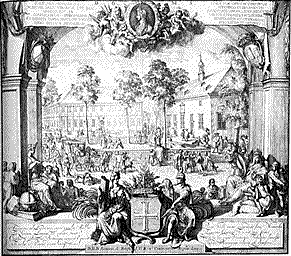5. Lingen
The County of Lingen belonged since 1496 to the rule
of the Count of Tecklenburg. Konrad of Tecklenburg introduced the Lutheran
Reformation in 1541. New preachers were installed and its own church
constitution was introduced (in 1543). This phase ended five years later,
however, because Konrad lost the rule over Lingen.
The decisive date for the introduction of the Reformed Reformation in
the County of Lingen is the year 1578. For it was then that the County
of Lingen came under the control of the Reformed House of Orange. The
Prince Maurice of Nassau-Orange reformed the congregations from 1597
by causing the gospel to be preached. And although there was apparently
no pressure exerted, most of the inhabitants turned to the Reformed confession.
In 1605 however, Lingen was conquered by Spinola, commander in Spanish
services, and the county was re-Catholicised. And with success – for
the still young movement of the Reformed confession had not yet been
able to root itself deeply enough. In 1524 the Reformed preacher Melchior
Balthasar was executed in Meppen. In 1633 the rule changed again – Orange
took over Lingen once more. From 1634 there was a Reformed service in
Lingen once more. Reformed preachers were also appointed in several other
congregations. At this point, however, a split existed: the overwhelming
majority of the population was and remained Roman Catholic, a minority
Reformed. A brief interlude in 1673/74, in which the Bishop of Munster,
who had conquered the County of Lingen, reigned, caused a change in trend
in favour of the Roman Catholic Church. But already in 1674, the members
of the House of Orange took over the rule in the County of Lingen once
again. Because of the numerous changes in the past few years, the majority
of the population were unwilling to make yet another change of confession.
The Reformed preachers were not accepted in a friendly manner, and forbidden
Roman Catholic services took place, sometimes in emergency churches outside
the country.
In 1678 its own church constitution was drawn up on the Dutch model,
later becoming the model for the church constitution of the County of
Bentheim. It emphasises the Reformed principles of the Heidelberg Catechism,
entrusts the church councils with the leadership of the congregation
and states expressly that none of the congregations are to have power
over any other.
In 1693 the high school in Lingen was set up, at which theology, law,
medicine and philosophy could be studied. It was closed in 1820. Individual
buildings of the high school are still to be found in Lingen today.
 |
Hohe Schule Lingen 1694 |
From 1702 the County of Lingen belonged to Prussia, whereby little changed
for the congregations, their language and church hymns remaining Dutch
(into the 19th Century). The rule changed again in 1815, the Lower County
of Lingen being ascribed to the Kingdom of Hanover, while the Upper County
remained with Prussia.
The Reformed congregations in today’s Emsland belong to the “Protestant
Reformed Church. Synod of Protestant Reformed churches in Bavaria and
North West Germany.”